Estimated reading time: 10 minutes
Brushing your dog’s teeth can often feel like a battle of wits and patience. Dental care is vital for your furry friend’s overall health, with many dogs showing signs of gum disease by the age of three.
This article offers practical tips and strategies to make toothbrushing less stressful for both you dog owners out there and your pups. Keep reading to transform this chore into a bonding experience!
Key Takeaways
- Start brushing your dog’s teeth slowly and be patient. Use a soft toothbrush or gauze, touch only a few teeth at first, and increase with time.
- Get pet toothpaste in yummy flavors like chicken or peanut butter. Let your dog taste it before starting to brush.
- Give treats and praises when your dog lets you check their teeth or touch their mouth. This makes them more okay with toothbrushing later on.
- Try other ways to clean your dog’s teeth if they really don’t like brushing. You can use dental chews, water additives, sprays, and gels to help keep their mouth healthy.
- Always look for signs that your dog is not happy during teeth cleaning. Stop if they seem upset and never force them. That way brushing stays a good thing for both of you!
Understanding Your Dog’s Perspective
Your furry friend might see tooth brushing as a scary thing. Dogs use their mouths to explore the world, so having something new like a toothbrush in there can feel very odd to them.
They don’t understand that it’s for keeping their teeth clean and healthy. Imagine someone coming at you with a stick and wanting to put it in your mouth – you’d want to know why, right?
Now think about how dogs communicate. A lot of what they do is through body language, not words. When we try tooth brushing without explaining it in dog terms, they might get nervous or scared because they just don’t get what’s happening.
It’s important to show them there’s nothing to fear and that this strange new routine is actually good for them.
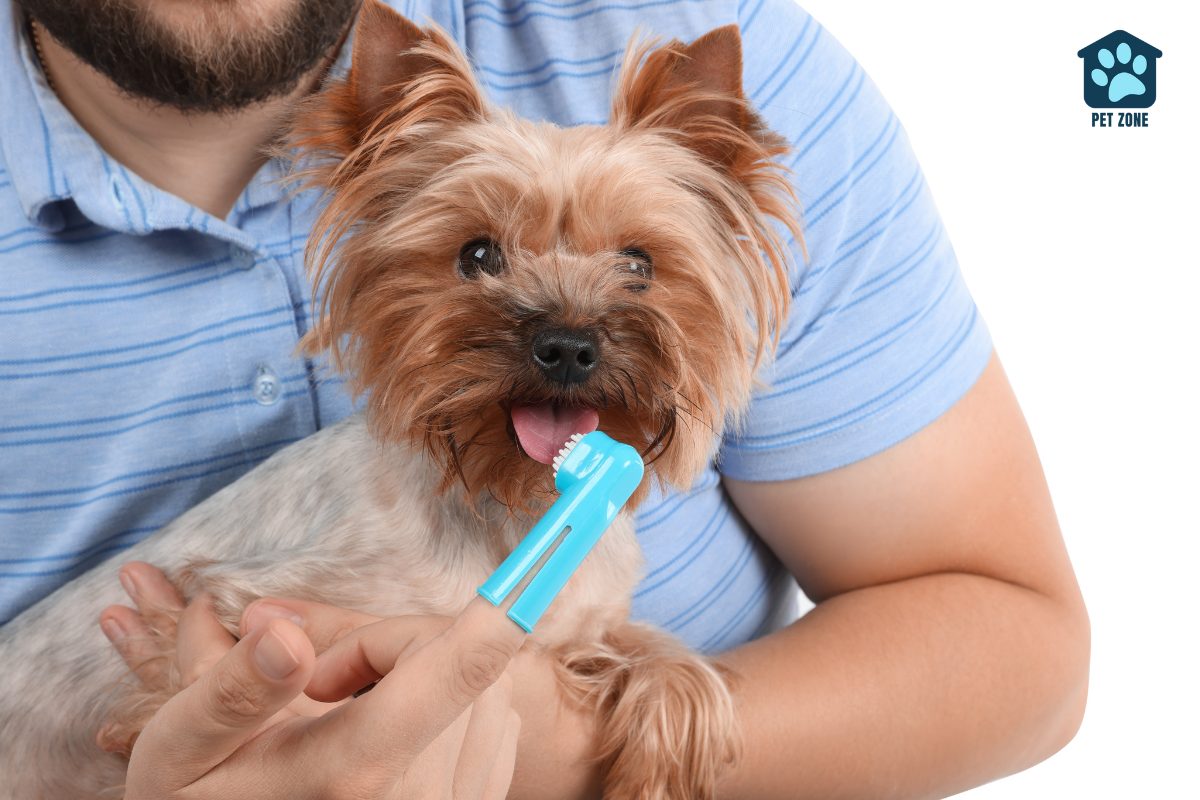
Tips for Dogs that Dislike Teeth Brushing
If your dog isn’t a fan of teeth brushing, there are some strategies you can try to make the process more tolerable. This includes gradually introducing the toothbrush and pet toothpaste, building up the routine over time, and reassuring and rewarding your dog throughout the process.
Checking the Dog’s Teeth
Before you brush, examine your dog’s mouth for any issues. Gently lift the lips to check teeth and gums. Look for signs of redness or tartar build-up. If you spot anything unusual like bad breath, swollen gums, or loose teeth, call your vet.
Make sure to get a good look at the back teeth too. These are often missed but can have lots of plaque. It’s best to do this when your dog is calm and relaxed so they don’t mind you looking in their mouth.
Checking first helps you know if it’s safe to brush without hurting them.
Gradual Introduction to the Mouth
Getting your dog comfortable with having its mouth touched is key to successful teeth brushing. Start slow and use these steps to help your dog accept the process.
- Lift your pup’s lip gently. Praise them when they allow it, building trust.
- Touch the teeth and gums softly with your finger. Offer a treat as a reward for staying calm.
- Let your dog taste some dog-friendly toothpaste. Put a small amount on your fingertip.
- Practice this without brushing. Just let them get used to the flavor and sensation.
- Choose a quiet time when your pet is relaxed for these exercises. This makes learning easier.
- Add short sessions each day, so your dog gets used to you touching their mouth.
- Increase contact time gradually. Your goal is to touch all the teeth eventually.
- Use positive reinforcement always. Give praise or treats for cooperation and patience.
Introducing Pet Toothpaste
Ensure your dog’s oral health by introducing pet toothpaste, specially designed to meet their needs. Human toothpaste can be harmful so it’s crucial to use dog-specific toothpaste, safeguarding their overall well-being.
Look for flavors your pet enjoys – chicken and peanut butter are often popular choices. Gradually introduce the toothpaste to get them used to the flavor and to associate it with a positive experience, making brushing a more pleasant routine.
Introducing the Toothbrush
For introducing the toothbrush, start by choosing a soft child’s toothbrush or gauze swabs for dogs who hate teeth brushing with a normal dog toothbrush. These options can be more manageable and less intimidating for your dog, especially if they are uncooperative.
Additionally, human toothbrushes with soft bristles or finger-brushes are suitable alternatives for smaller dogs as part of the dog teeth-brushing routine. Both these tools allow you to effectively clean your dog’s teeth without causing discomfort or harm.
Importantly, finger brushes offer a more tactile approach, giving you better control and sensitivity during the brushing process.
Building Up the Routine Over Time
To build up the routine over time:
- Start with a few easy-to-reach teeth and gradually increase the number each day to help your dog get used to teeth brushing.
- Decide on a specific time for brushing your dog’s teeth, beginning with once a week until your dog becomes accustomed to it.
- Keep brushing sessions short and praise your dog while brushing to help them adjust to the process smoothly.
Reassuring and Rewarding the Dog
When brushing your dog’s teeth, reassure and reward them to make the experience positive. Use a little toothpaste on their brush and let your dog lick it off as a gradual introduction.
Brush their teeth when they are calm and relaxed, offering rewards like dental treats to associate positivity with the process.
Focus on rewards while brushing your dog’s teeth; start by letting them lick off toothpaste from the brush as an introduction. Ensure your dog is calm for the best experience and offer rewards such as dental treats to associate positivity with tooth brushing.
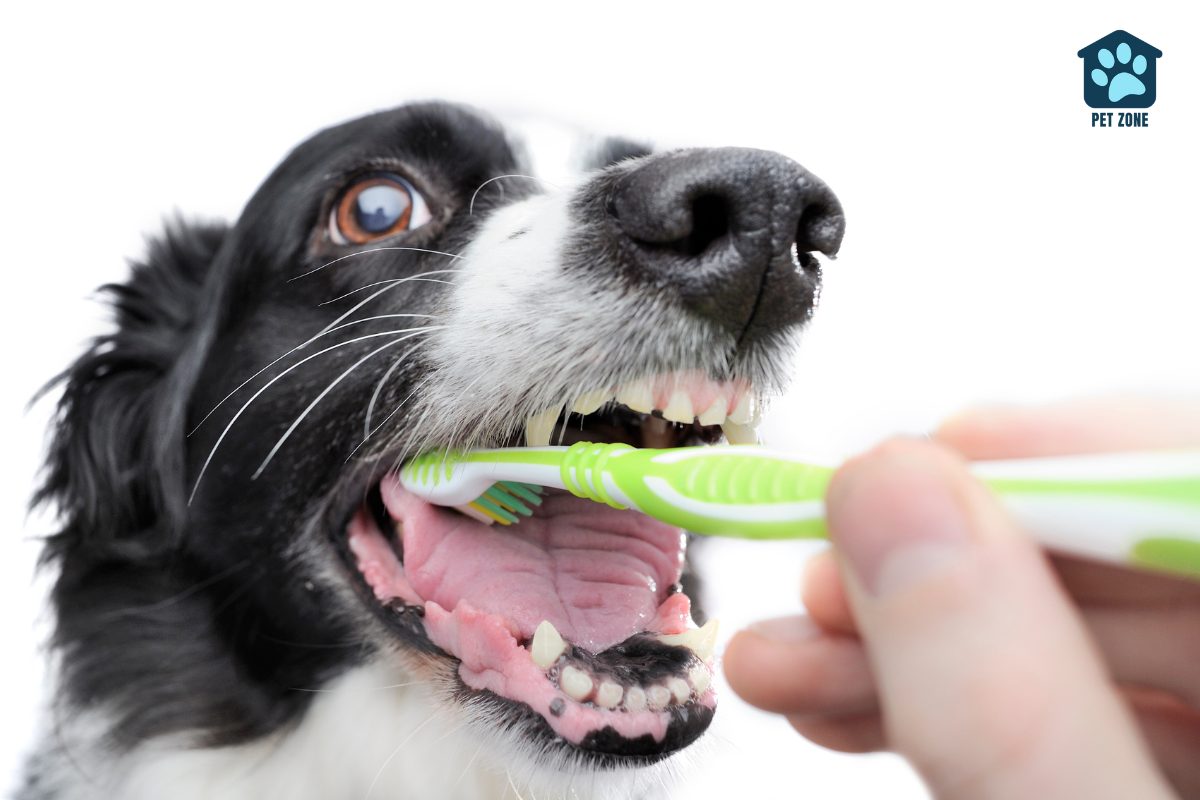
Alternative Methods to Cleaning Dog Teeth Without Brushing
If your dog refuses to let you brush their teeth, there are alternative methods to maintain their dental health. From using dental wipes and sprays to offering dental chews and water additives, there are plenty of options to explore.
The Chewing Method
Consider implementing the chewing method to maintain your dog’s dental health. Chews such as raw bones, dental chews, and toys can help remove plaque and keep their teeth clean without brushing.
While dry dog food aids in exercising their chewing muscles, it also provides a mild cleaning effect on their teeth. These methods offer an effective alternative for maintaining your dog’s oral hygiene.
Remember that dry dog food supports mild cleaning while various chews effectively aid in removing plaque – making them beneficial options to ensure your furry friend’s dental well-being!
The Use of Sprays, Gels, and More
Sprays and gels are effective for killing plaque-causing bacteria and softening plaque. These products make dental care convenient, as you can apply them directly into your dog’s mouth.
For dogs resistant to teeth brushing, sprays and gels improve the overall experience by providing an alternative way to maintain their oral health. Regular use of these products assists in loosening and removing plaque, promoting healthier gums and teeth.
Incorporating sprays and gels into your dog’s routine supports a positive approach to dental care without the challenge of traditional brushing methods.
Dental Chews and Water Additives
Dental chews act as a supplement to regular toothbrushing, helping control plaque and tartar buildup. They can be an effective option for cleaning your dog’s teeth without brushing and contribute to overall oral hygiene.
Water additives function like mouthwash, promoting healthy teeth and gums by controlling plaque and tartar. While these are not substitutes for traditional toothbrushing, they serve as valuable additions to your dog’s dental care routine.
Remember, with the help of dental chews and water additives, you can enhance your furry friend’s oral health alongside regular toothbrushing. These options offer an extra layer of protection against plaque and tartar while supporting fresh breath—benefits that contribute to your dog’s overall well-being!
Considerations Before Brushing Dog’s Teeth
When preparing to brush your dog’s teeth, it’s important to consider the timing and technique that works best for them. The length of time spent brushing and how you approach the process can significantly impact your dog’s willingness to cooperate.
Timing and Technique
Brush your dog’s teeth every day if possible, but a few times a week is also beneficial. Start slowly and gradually increase the amount of time spent brushing and the number of teeth cleaned as your dog gets used to it.
Ideally, aim for daily brushing or at least three times a week to effectively remove plaque and prevent tartar buildup. Stop if you notice any signs of discomfort from your dog, and make sure the process is associated with positive experiences through reassurance and rewards.
Gradual introduction to tooth brushing can help your dog accept the routine over time, improving their dental health without causing stress or discomfort.
Length of Time
When brushing your dog’s teeth, aim for two minutes total. Start by brushing a few teeth at a time and gradually increase the number each day.
Vets recommend daily brushing for optimal oral hygiene, with some suggesting twice per day is best to remove plaque and prevent tartar accumulation. Brushing three times a week is the minimum recommendation, aiming ultimately for two minutes of total brush time.
Remember not to start cleaning its whole set of teeth all at once; progress gradually to ensure thorough cleaning while being mindful of their comfort level. Work up from just a few teeth during initial sessions.
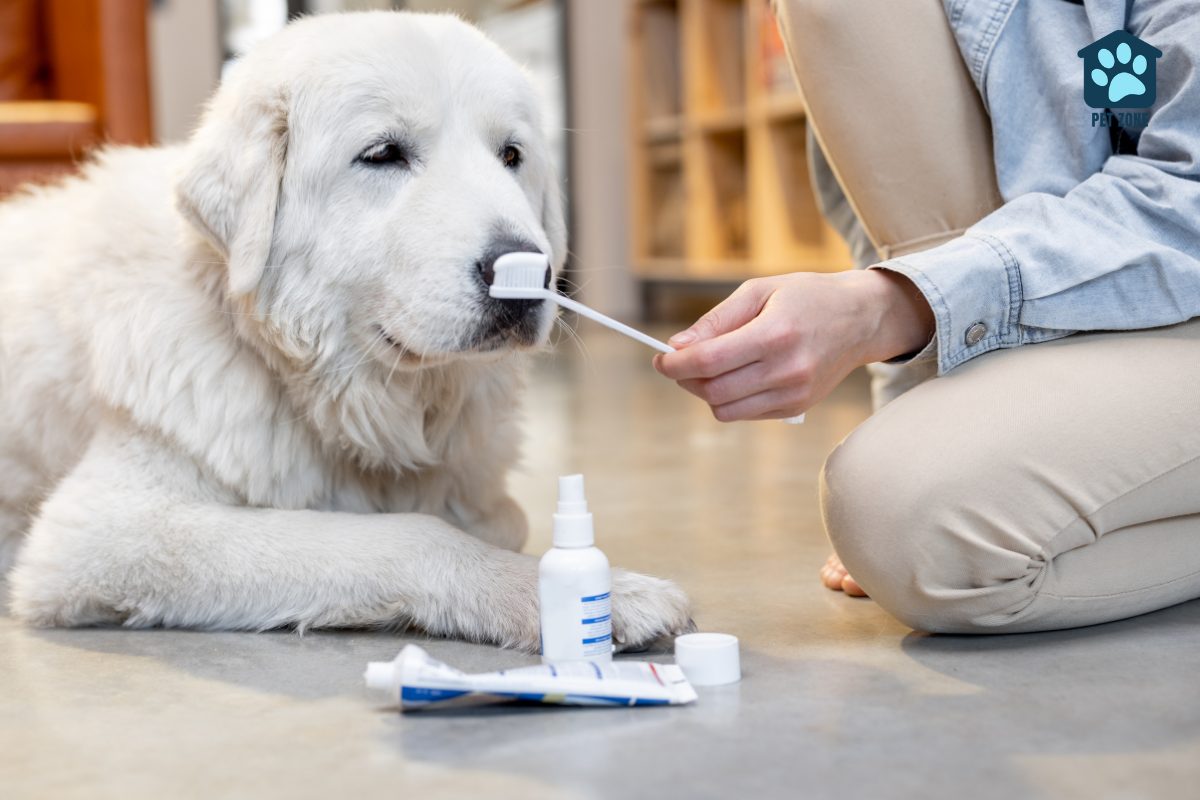
Conclusion
In conclusion, offering patience and consistency in introducing tooth brushing to your dog is key. Remember to keep sessions calm and gradual, ensuring positive associations with the process.
Utilize high-quality treats and alternative cleaning methods to maintain your dog’s dental health. Stay attentive to their cues and comfort throughout the teeth-brushing routine, making it a positive experience for both you and your furry friend.
Frequently Asked Questions
Never use human toothpaste on your dog’s teeth because it can be harmful to your dog. Get special dog toothpaste that is safe and designed for dogs.
If your pup hates brushing, try using a finger brush or give them dental chews instead. These methods clean teeth without the need for a traditional brush.
To keep your pet’s pearly whites shiny, you can add coconut oil to your dog’s food or apply it with a cloth to their gums and teeth.
Yes, there are plenty of treats made specifically to help maintain canine dental health without brushing daily—just make sure they’re the best kind for cleaning!
Gradually get your fur baby used to the idea by letting them taste pet-friendly toothpaste and gently rubbing their gums before moving on using a brush.
Regular dental check-ups along with daily cleaning habits at home will help protect against issues in both dogs and cats—the key is starting these routines early!
As an Amazon Associate I earn from qualifying purchases.
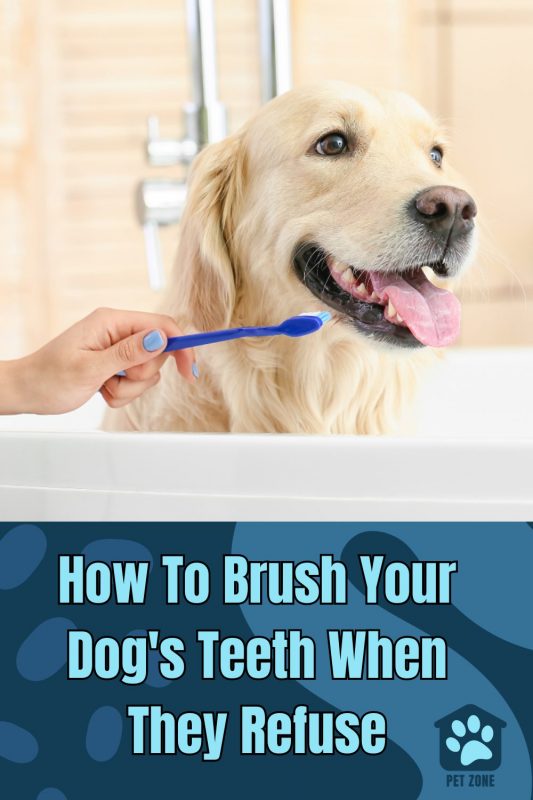


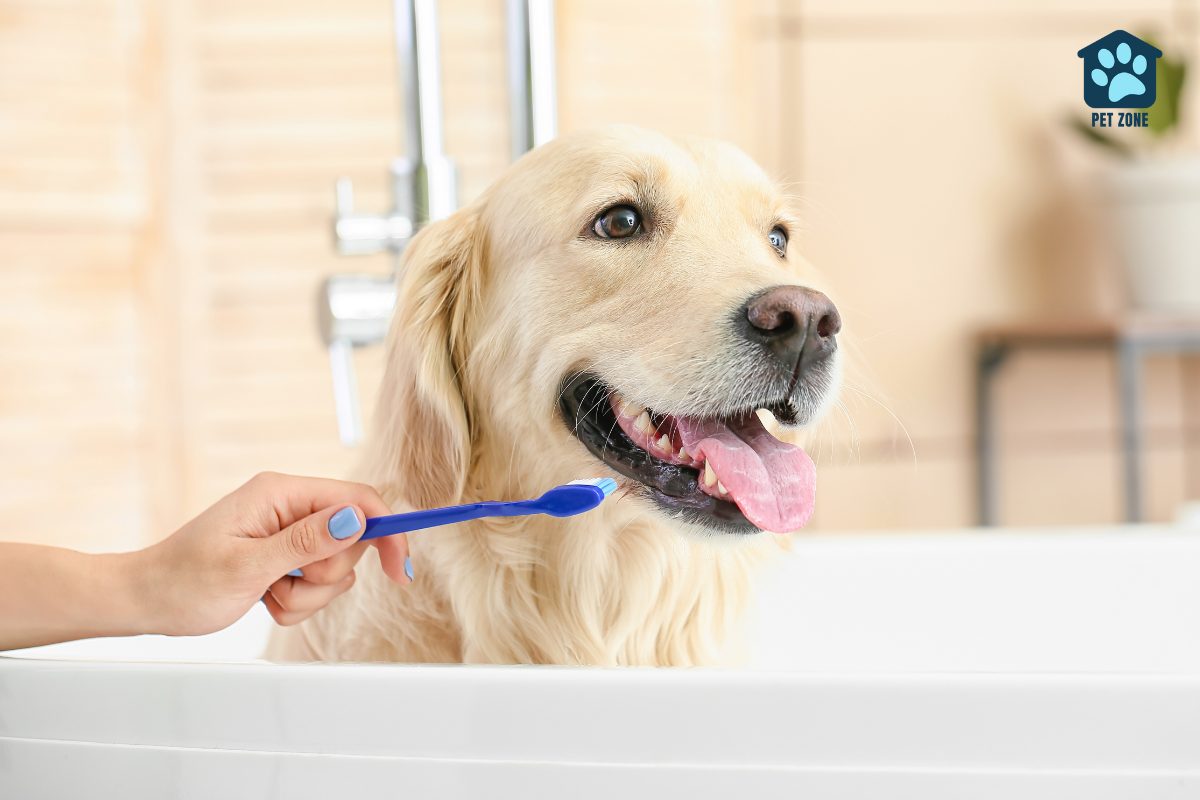


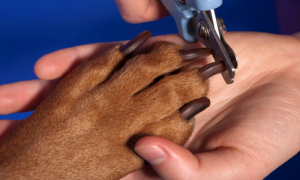
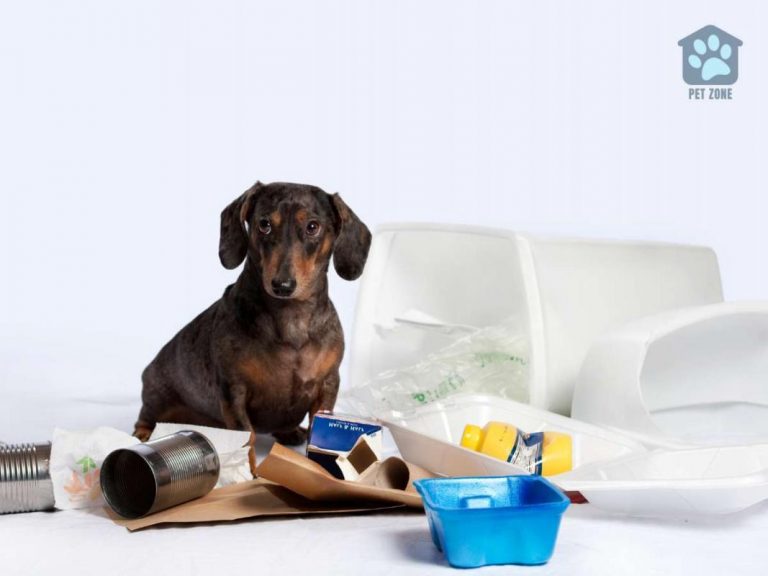
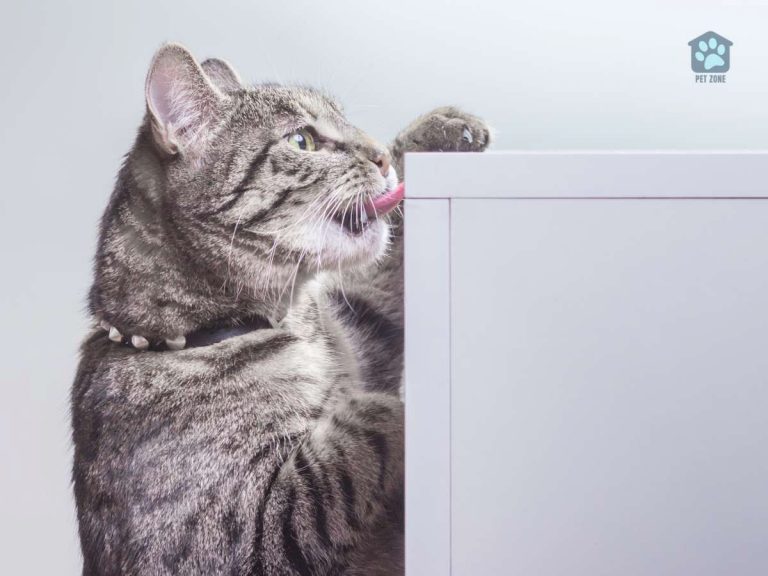
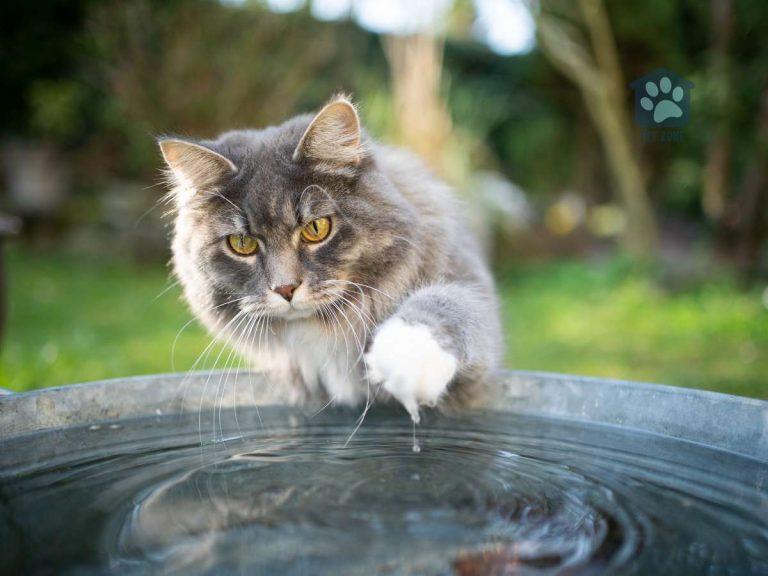
I didn’t know you could actually brush a dog’s teeth. I remember when we had our dog (many years ago), we would give them these treats that was suppose to be for the health of their teeth. Great post! I learned something new.
I wish I had read this years ago before we adopted our dog! But still some helpful information going forward in maintaining her dental health. Thanks as always.